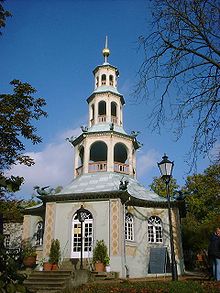
Dragon House (Sanssouci)
Encyclopedia

Potsdam
Potsdam is the capital city of the German federal state of Brandenburg and part of the Berlin/Brandenburg Metropolitan Region. It is situated on the River Havel, southwest of Berlin city centre....
, Germany
Germany
Germany , officially the Federal Republic of Germany , is a federal parliamentary republic in Europe. The country consists of 16 states while the capital and largest city is Berlin. Germany covers an area of 357,021 km2 and has a largely temperate seasonal climate...
, built by King Frederick the Great of Prussia on the southern slope of the Klausberg, which borders the northern edge of Sanssouci Park
Sanssouci Park
Sanssouci Park is a large park surrounding Sanssouci Palace in Potsdam, Germany. Following the terracing of the vineyard and the completion of the palace, the surroundings were included in the structure. A baroque flower garden with lawns, flower beds, hedges and trees was created. In the hedge...
. It was constructed between 1770 and 1772 in the prevailing Chinoiserie
Chinoiserie
Chinoiserie, a French term, signifying "Chinese-esque", and pronounced ) refers to a recurring theme in European artistic styles since the seventeenth century, which reflect Chinese artistic influences...
taste of the time, designed to imitate a Chinese pagoda
Pagoda
A pagoda is the general term in the English language for a tiered tower with multiple eaves common in Nepal, India, China, Japan, Korea, Vietnam and other parts of Asia. Some pagodas are used as Taoist houses of worship. Most pagodas were built to have a religious function, most commonly Buddhist,...
. Carl von Gontard
Carl von Gontard
Carl von Gontard was a German architect; he worked primarily in Berlin, Potsdam, and Bayreuth....
was commissioned to build it.
The Dragon House is named after the sixteen dragon
Dragon
A dragon is a legendary creature, typically with serpentine or reptilian traits, that feature in the myths of many cultures. There are two distinct cultural traditions of dragons: the European dragon, derived from European folk traditions and ultimately related to Greek and Middle Eastern...
s on the corners of its concave roofs. Six years after the construction of the Chinese House
Chinese House (Potsdam)
The Chinese House is a garden pavilion in Sanssouci Park in Potsdam. Frederick the Great had it built, about seven hundred meters southwest of the Sanssouci Summer Palace, to adorn his flower and vegetable garden...
in Sanssouci Park, Frederick's enthusiasm for Chinoiserie park structures was expressed once again with this creation.
Frederick the Great was stimulated to build in a Far East
Far East
The Far East is an English term mostly describing East Asia and Southeast Asia, with South Asia sometimes also included for economic and cultural reasons.The term came into use in European geopolitical discourse in the 19th century,...
ern style by Sir William Chambers
William Chambers (architect)
Sir William Chambers was a Scottish architect, born in Gothenburg, Sweden, where his father was a merchant. Between 1740 and 1749 he was employed by the Swedish East India Company making several voyages to China where he studied Chinese architecture and decoration.Returning to Europe, he studied...
's Designs of Chinese Buildings" (1757) and from his Plans, elevations, section and perspective views of the gardens and buildings at Kew" (1763). These architectural reference books were given to Frederick by the author, who had created for Augusta, Princess of Wales
Princess Augusta of Saxe-Gotha
Princess Augusta of Saxe-Gotha-Altenburg was Princess of Wales between 1736 and 1751, and Dowager Princess of Wales thereafter. She was one of only three Princesses of Wales who never became queen consort...
a large garden at Kew
Royal Botanic Gardens, Kew
The Royal Botanic Gardens, Kew, usually referred to as Kew Gardens, is 121 hectares of gardens and botanical glasshouses between Richmond and Kew in southwest London, England. "The Royal Botanic Gardens, Kew" and the brand name "Kew" are also used as umbrella terms for the institution that runs...
(near London), in which there still stands Chambers's many-tiered tapering pagoda, completed in 1762.
The Dragon House at Sanssouci was built on an octagonal plan, with four floors not only to be decorative, but also as living quarters for the wine-growers who worked on the neighbouring Weinberg. However, they did not move into the pagoda. To save the pagoda from its dilapidated state, it had to be restored in 1787. Ever since then it has been constantly inhabited by the overseer of the Belvedere on the Klausberg
Belvedere auf dem Klausberg
The Belvedere auf dem Klausberg is a building in Sanssouci Park in Potsdam, Germany.-Architecture:Georg Christian Unger based his plans on a drawing by the Italian archeologist Francesco Bianchini from his 1738 volume Del Palazzo de' Cesari. Biancini had tried to reconstruct the Imperial Palace on...
. Over the years, because of its inhabitation, an additional room, a laundry and three stables have extended the two rooms—a kitchen and an entrance hall—of the structure. The Dragon House has been used since 1934 in a gastronomical capacity.
Sources
This article is adapted from its German equivalent- Generaldirektion der Stiftung Schlösser und Gärten Potsdam-Sanssouci (Hrsg.): Potsdamer Schlösser und Gärten. Bau- und Gartenkunst vom 17. bis 20. Jahrhundert. UNZE VG mbH, Potsdam 1993 ISBN 3-910196-14-4

